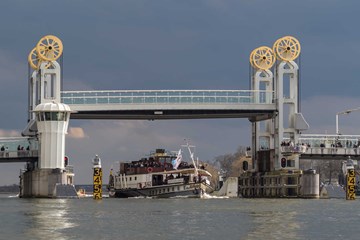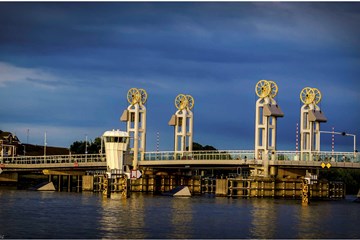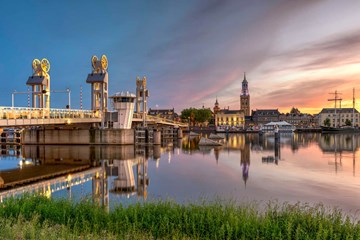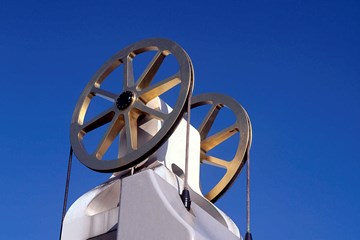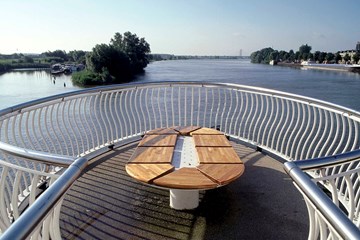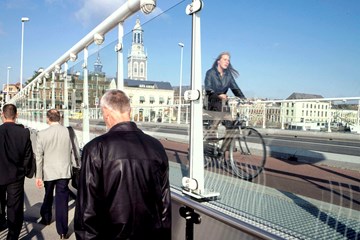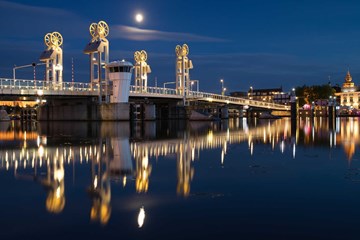Stadsbrug, Kampen
Nieuwe brug in oude stad
Tussen het oude stadscentrum van Kampen en het stationsplein stroomt de IJssel. De brug die beide stadsdelen verbindt is niet alleen een belangrijke verbinding, maar ook een gezichtsbepalend onderdeel van het centrum van de stad. Toen de oude brug vervangen diende te worden kreeg architectenbureau ZJA de opdracht een nieuwe brug te ontwerpen. De vraag was hoe een hedendaagse brug zou passen in dat beschermde historische stadsgezicht, en iets waardevols kon toevoegen.
De eerste beslissing was om de brug op dezelfde plek, passend in het middeleeuwse stratenpatroon te leggen. Dat vereiste tijdens de bouw wel dat er een tijdelijke verbinding moest worden aangelegd, maar zorgt er wel voor dat de nieuwe brug, die twee keer zo breed is als de oorspronkelijke brug, beter past in het aanzicht van de monumentale kade. De tweede ontwerp-beslissing was om de doorgang voor de scheepvaart te verdubbelen naar dertig meter. Omdat de IJssel, ook met het oog op de klimaatverandering in de toekomst extra ruimte nodig zal hebben, zijn de oude massieve kolommen en landhoofden vervangen door slankere kolommen. Dat verbetert de doorstroming van het water.
Torens met gouden wielen
Wat is het meest doelmatig en past het beste op zo’n plek? Een ophaalbrug? Een draaibrug of een staartbrug? Gekozen werd voor een hefbrug, steunend op vier tussensteunpunten waartussen het dek omhoog gehesen wordt. Behalve dat dit een statig en monumentaal beeld oplevert gaf het de kans de benodigde machinerie uit het water te laten, wat weer bijdraagt aan het terugdringen van stuw bij hoogwater. De vier heftorens zijn stalen kolommen die gevuld zijn met beton. Het zijn slanke torens die licht naar elkaar buigen. Ze zijn bekroond met evenwichtswielen waarover de kabels lopen voor het contragewicht. Om aan te sluiten bij de monumentale en historische omgeving zijn de evenwichtswielen niet overdekt, maar vrij zichtbaar gelaten. Bovendien zijn ze overdekt met bladgoud en weerspiegelen ze het licht dat ze vangen van boven en vanaf de waterspiegel. Het zijn sterke maar sierlijke mechanische lichamen, die de krachten die in het spel zijn met een zekere zwier aan de wereld tonen. Ze trekken net als de gouden weerhanen en ornamenten op de vele kerktorens van Kampen de ogen van bewoners en bezoekers van grote afstand. En niet alleen overdag, na zonsondergang worden de heftorens door een uitgekiend lichtplan aangelicht. Dit ontwerp levert een functionele en visueel aantrekkelijke brug, die zowel hedendaags als monumentaal werkt. Het is een gezichtsbepalende toevoeging aan het centrum van Kampen.
Langzaam verkeer en het uitzicht
Naast het betonnen dek met de rijweg voor auto’s en aparte fietspaden zijn er aan weerszijden verlaagde voetpaden aangebracht. Daartussen staat een glazen windscherm. De verlaagde voetpaden hangen aan staalconstructies aan de buitenkant van de brug, waardoor de voetgangers een schitterend zicht op de rivier, de schepen, de stad en het omringende land hebben. Halverwege de brug, bovenop de dukdalven en houten beschoeiing die de heftorens beschermen tegen eventuele botsingen van schepen, zijn balkons aangebracht, die het gevoel geven boven de rivier te zweven. Je bent er dicht bij de grote en wispelturige kracht van de rivier. Vloeiende lijnen in het hekwerk omsluiten een houten bank en een tafel. Het zijn nieuwe plekken om een tijd te verblijven en te genieten van het uitzicht op de stad, de aanblik van komende en gaande schepen en van het licht over de fiere torens met hun gouden wielen.
Architect: ZJA
Opdrachtgever: Gemeente Kampen
[English]
New bridge in an old town
Between the historic centre of Kampen and its station square lies the River IJssel. The bridge connecting the two parts of the town is not just an important link but a vital feature of the town centre. When the old structure needed to be replaced, architectural studio ZJA was commissioned to design a new bridge. The question was how to come up with a contemporary design that would be in keeping with the historical townscape, protected as a heritage site, while also adding something of value.
The first decision was to put the new bridge in the same place, thereby fitting it into the mediaeval street pattern. This meant that during building work a temporary crossing would have to be provided, but it also ensured that the new bridge, which is twice as wide as the original, would be in keeping with the historical waterfront. The second design decision was to double the breadth of the shipping channel to thirty metres. Because the IJssel will need extra space in the future, partly in view of climate change, the old heavy pillars and abutments were replaced with slender columns. This improves the flow of the water.
Towers with gold wheels
What is both most functional and best suited to such a position? A drawbridge? A swing bridge or a cable-stayed bridge? The decision was made to create a lift bridge, resting on four central supports between which the deck can be lifted. Aside from the fact that this would create a stately, historically authentic impression, it offered an opportunity to keep the required machinery out of the water, which helps to limit surge at times of high water. The four lifting towers are steel columns filled with concrete. They are slim and bend towards each other slightly. At the top they are crowned by pulley wheels, with cables running over them for the counterweight. To help ensure the bridge fits in with the historical, landmark setting, the wheels are not covered but left visible. Furthermore, they are gold plated, so they reflect the light falling from above and bouncing off the surface of the water. These are strong but elegant mechanical elements that, with a certain panache, demonstrate to the world the forces at play. Like the gold weathercocks and ornaments on Kampen’s many church towers, they draw the eye of residents and visitors from a long distance. And not just in daytime, since after sunset the lifting towers are illuminated according to a sophisticated lighting plan. This design delivers a bridge that is both functional and visually attractive, contemporary yet also historically authentic. It is an important addition to the look of Kampen town centre.
Slow traffic and the view
As well as the concrete deck with lanes for cars and separate bicycle paths, lower pedestrian walkways have been added on both sides. Between them and the roadway is a glass windbreak. The low footpaths hang from steel structures on the outside of the bridge, giving pedestrians a beautiful view of the river, the ships, the town and the surrounding landscape. In the middle of the bridge, on top of the mooring dolphins and the wooden planks that protect the towers from collision by shipping, balconies have been added that give a sensation of floating just above the river, close to its immense and volatile power. Flowing curves in the balustrade enclose a wooden bench and a table. These are new places to linger for a while and enjoy a view of the town, the sight of shipping as it comes and goes, and the light playing on the proud towers with their gold wheels.
Architect: ZJA
Commissioned by: Kampen Town Council
Project partners
Related associations
Related projects
No results found
Did your company worked on this project? Go to the Public page and list yourself as a project partner to access your company only page
Which project partner should receive your project listing request?
Document generator
Thank you for using the document generator again! Click the button to start a free trial period of 5 documents.
Document generator
Your trial period has been expired. Please contact info@galleo.co.
Click the +Favorite button to add this project to your personal favorites

